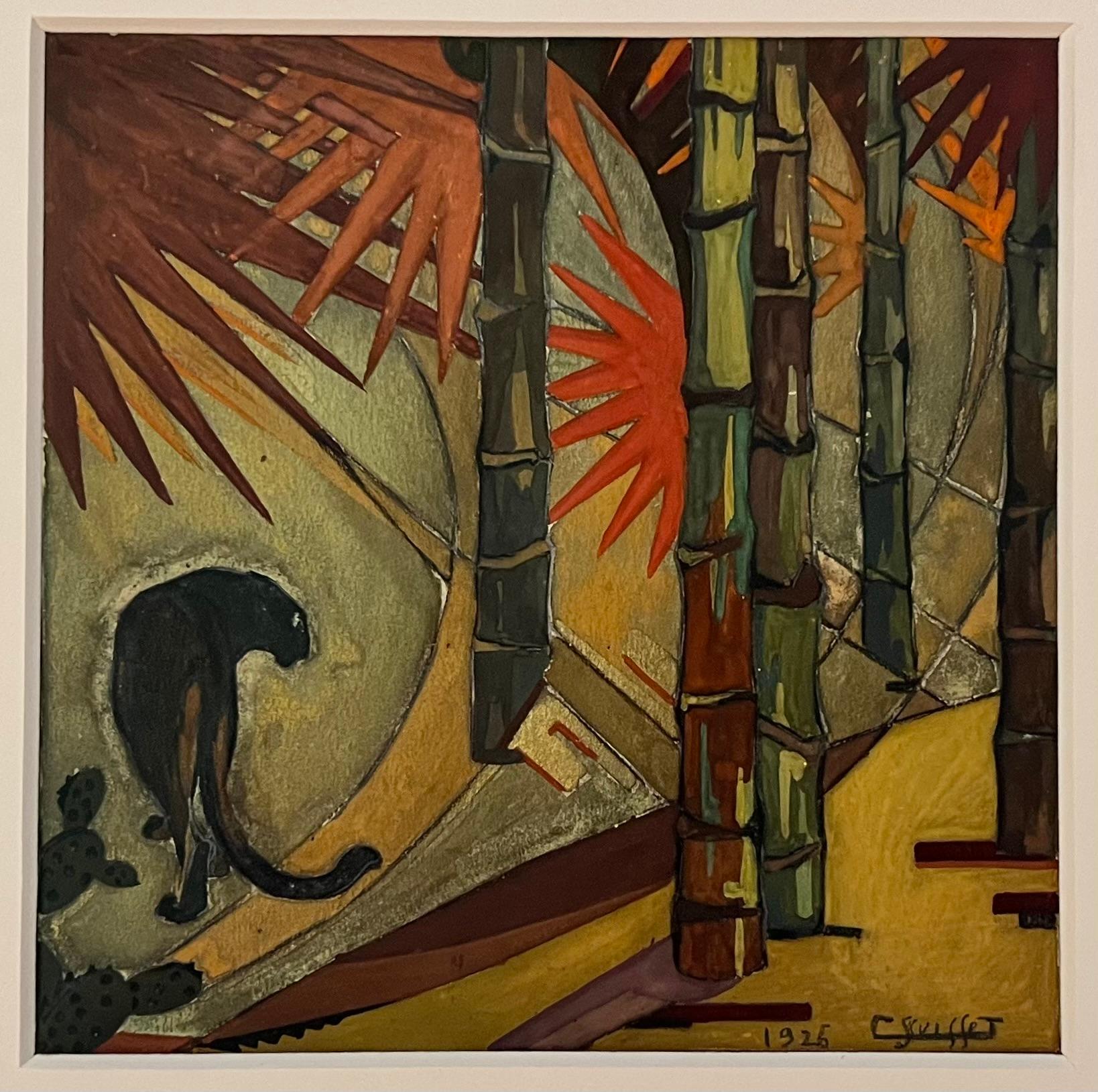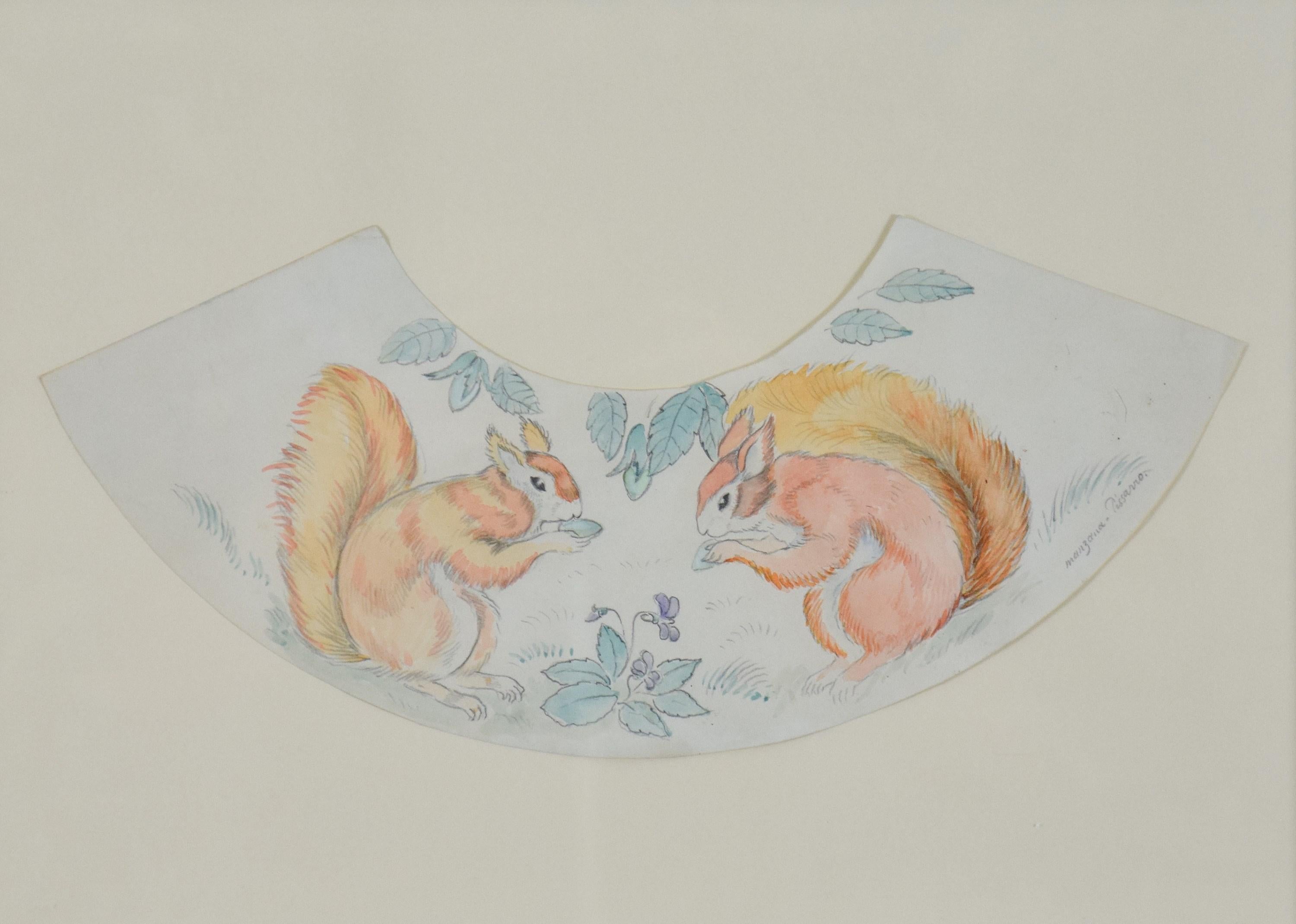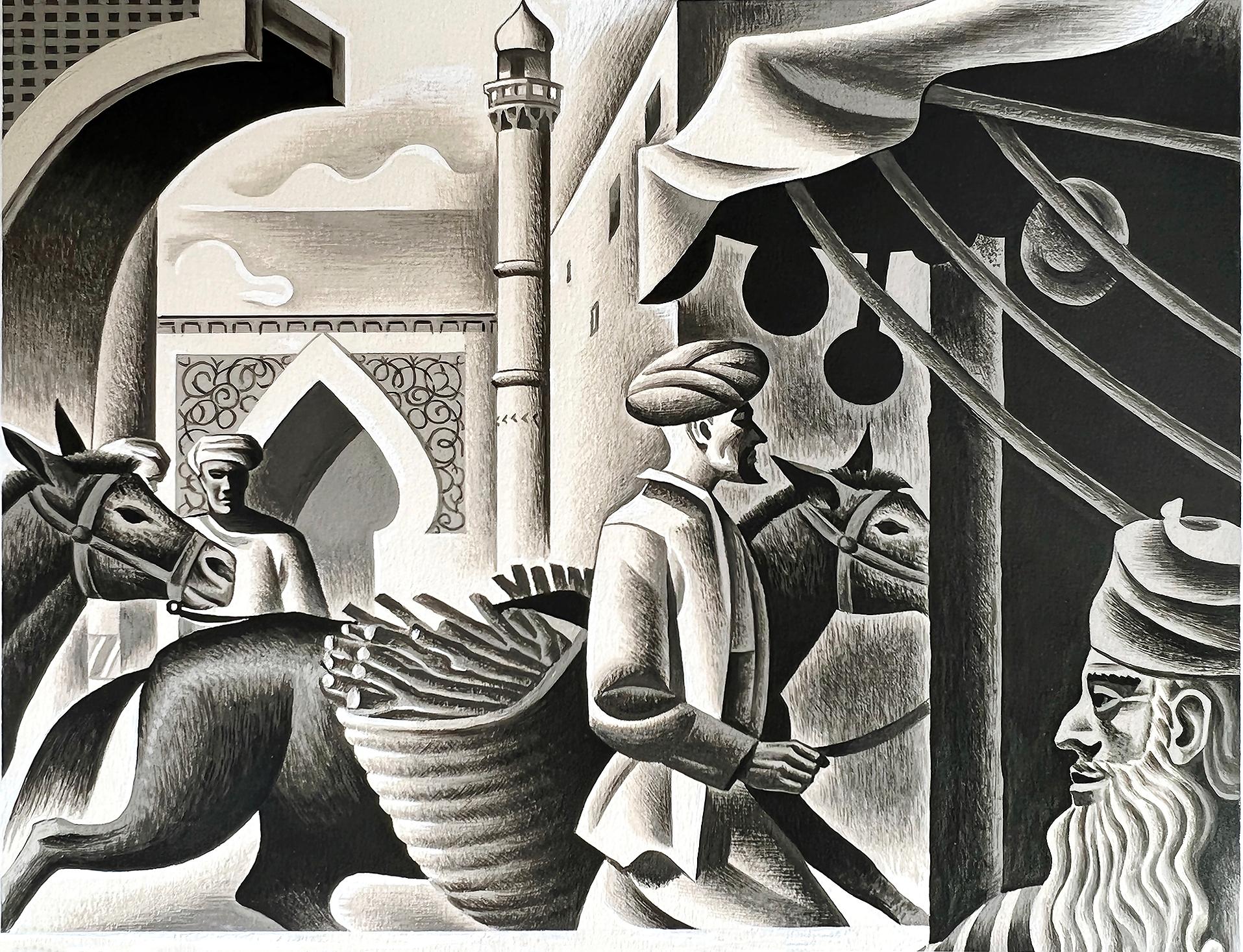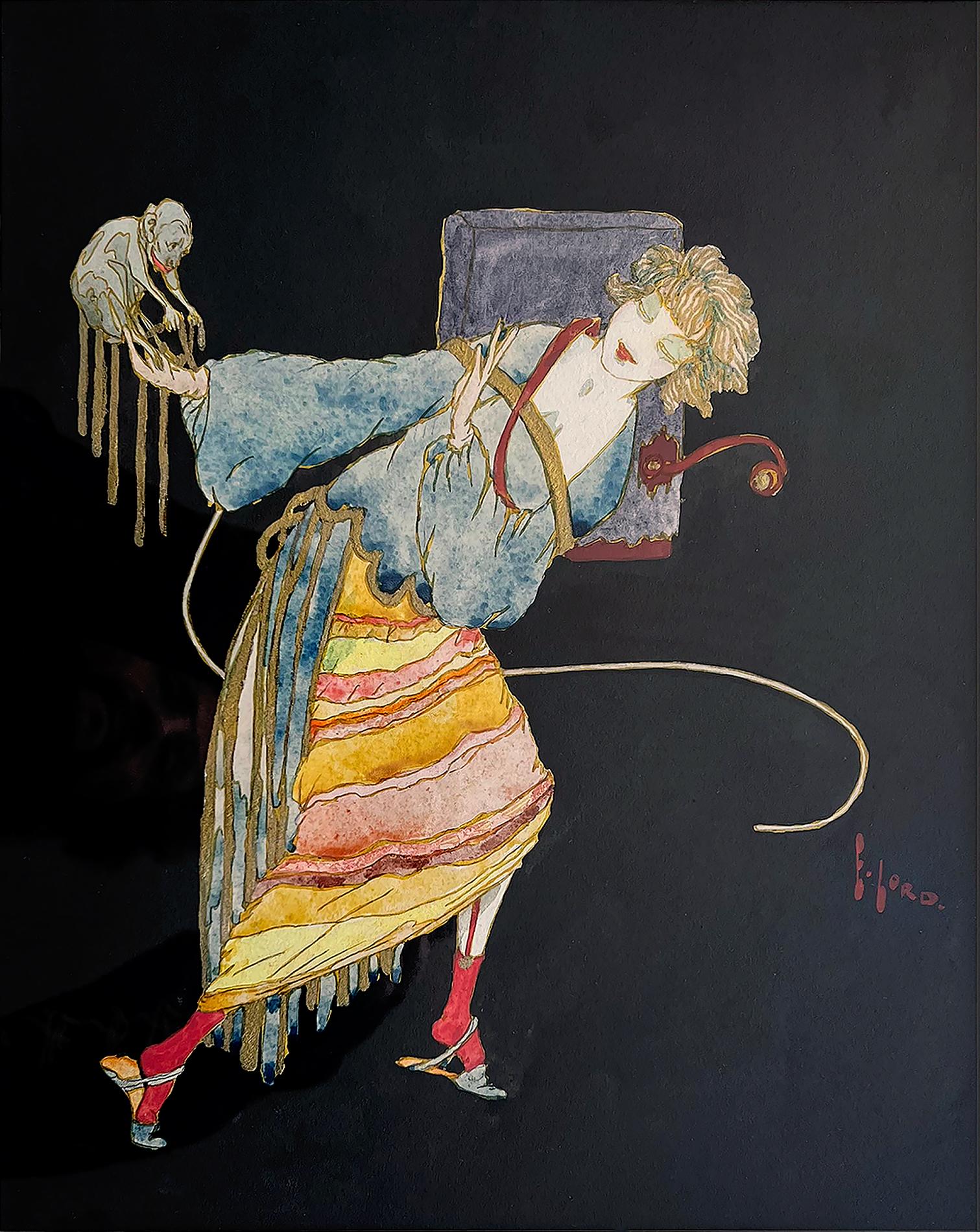Items Similar to Aranea diadima a study by Walter Spies, an artist living in Indonesia in the 30s
Want more images or videos?
Request additional images or videos from the seller
1 of 5
Walter SpiesAranea diadima a study by Walter Spies, an artist living in Indonesia in the 30s1925
1925
About the Item
Walter Spies was one of the first Europeans to settle in Bali after a stay in Java. He greatly contributed to the discovery and popularization of Balinese culture. Passionate about the study of nature, he produced many studies of insects in the Dutch naturalist tradition. In this watercolour from 1925, Walter Spies presents us with a spider, deliberately enlarged, both threatening and hypnotic.
1. Walter Spies, the adventurous life of a multi-talented artist
Walter Spies was born on 15 September 1895 in Moscow, where his father was a diplomat. After studying painting and music in Germany, he embarked in 1923 for Java, then under Dutch rule. He was welcomed to the court of the Sultan of Jogjakarta, who asked him to form a western orchestra, He also studied the local music, the gamelan.
In 1927 he moved to Bali, where he met the Mexican artist and anthropologist Miguel Covarrubias (1904-1957), then on his honeymoon with his wife Rose. Covarrubias wrote of their stay: "The months went by as Rose and I roamed all over the island with Spies, watching strange ceremonies, enjoying their music, listening to fantastic tales, camping in the wilds of West Bali or on the coral reefs of Sanur. Walter loved to collect velvety dragonflies, strange spiders and sea-slugs, not in a naturalist's box, but in minutely accurate drawings. For days at a time he would be in his tent drawing them, because once dead, their beautiful colours disappeared. "
Spies discovered Balinese music, which he was the first to record. He collected all the island's art forms, opening the first museum on the island and becoming its first curator. Having initially lived near Ubud in central Bali, in 1937, he moved to the Kerangasem district on the northeast tip of the island. He made friends with most of the Western travellers, whom he welcomed into his home, such as the Swiss painter Theo Meier (1908 - 1982) or the Austrian writer Vicky Baum (1888 - 1960). Baum wrote her masterpiece, Love and Death in Bali (published in 1937), thanks to Spies' insights into the island's history.
The end of Spies' life was more sombre: arrested in December 1938 as a homosexual, he was imprisoned until September 1939, when he was released thanks to the intervention of his friends, including the American anthropologist Margaret Mead (1901-1978), before being charged with paedophilia and arrested again. Interned as a German spy at the beginning of the Second World War, he was deported in 1942 on the SS Van Imhoff, which was sunk by a Japanese bomb en route to Ceylon. Walter Spies drowned like most of the prisoners on board.
2. Description of the artwork
This spider illustrates Spies taste for naturalist studies recorded by his friend Miguel Covarrubias. Dated 1925, it was probably done when the artist was staying at the court of the Sultan of Jogjakarta. The spider is shown in motion, perched on its long hairy legs. The details of the spider's body are rendered in meticulous and rich colour. The spiders eye seems to stare at the viewer, as if to hypnotize us into its web.
The artist uses the Nordic tradition of nature studies, in an art deco spirit, marked by the stylization of the animal, synthesized into almost geometric forms.
The inscription aranea diadima seems fanciful to us. Aranea diadima or Araneus diadematus is the scientific name for the garden spider, which is commonly found in Europe and North America but not in Java. While its colour can vary from beige to the darkest grey, it is recognisable by the white cross on its dorsal abdomen. We believe that Walter Spies used this name, which he knew, to describe a Javanese species that we have unfortunately been unable to identify.
The watercolor was done on strong cardboard, decorated with Chinese calligraphy on the back. It is difficult to say whether Walter Spies is the author of this calligraphy, which shows a certain mastery of the brush. The text does not seem to have been cut even though it is relatively obscure. The translation "shan qin hua hong - shi bu shi : the mountain is green, the flower is red - isn't it?” leads us to believe that it could be a calligraphic exercise rather than a real message. In any case, Walter Spies' use of it (the text is upside down when the cardboard is turned over) leads us to believe that it is certainly a reuse unrelated to the subject of the watercolour.
We have framed it in a gilded faux bamboo frame that emphasizes its exotic character.
- Creator:Walter Spies (1895 - 1942, German)
- Creation Year:1925
- Dimensions:Height: 8.27 in (21 cm)Width: 10.63 in (27 cm)
- Medium:
- Movement & Style:
- Period:
- Condition:Watercolor on cardboard showing Chinese characters on the back 21 x 27 cm (37.5 x 43.5 cm framed) Signed and dated on the left side "Walter Spies 1925" Framed in a gilded faux bamboo frame.
- Gallery Location:PARIS, FR
- Reference Number:1stDibs: LU156828947452
About the Seller
5.0
Vetted Seller
These experienced sellers undergo a comprehensive evaluation by our team of in-house experts.
Established in 2020
1stDibs seller since 2021
8 sales on 1stDibs
Typical response time: 2 hours
- ShippingRetrieving quote...Ships From: PARIS, France
- Return PolicyA return for this item may be initiated within 3 days of delivery.
More From This SellerView All
- A dazzling Venetian Regatta Boat Study attributed to Alessandra MauroLocated in PARIS, FRThis stunning Baroque study depicts a regatta boat, a type of vessel developed in eighteenth-century Venice for the regattas organized by the Serenissima during visits by royalty and...Category
Mid-18th Century Old Masters Figurative Drawings and Watercolors
MaterialsChalk
- Double-sided Horse Studies by Théodore GéricaultBy Jean Louis Andre Theodore GericaultLocated in PARIS, FRRecto: two horses, preparatory study for the lithograph "Les Boueux" ("The Muddy Ones") Verso: four studies of horse heads (including two preparatory studies for the watercolor "Plowing in England"), a study of a life guard with the rump of his horse (preparatory to the lithograph "A Party of Life...Category
1820s Old Masters Animal Drawings and Watercolors
MaterialsCarbon Pencil
- The Abduction of the Sabine Women , a Renaissance drawing by Biagio PupiniLocated in PARIS, FRThis vigorous drawing has long been attributed to Polidoro da Caravaggio: The Abduction of the Sabine Women is one of the scenes that Polidoro depicted between 1525 and 1527 on the façade of the Milesi Palazzo in Rome. However, the proximity to another drawing inspired by this same façade, kept at the Ecole des Beaux-Arts, and to other drawings inspired by Polidoro kept at the Musée du Louvre, leads us to propose an attribution to Biagio Pupini, a Bolognese artist whose life remains barely known, despite the abundant number of drawings attributed to him. 1. Biagio Pupini, a Bolognese artist in the light of the Roman Renaissance The early life of Biagio Pupini, an important figure of the first half of the Cinquecento in Bologna - Vasari mentions him several times - is still poorly known. Neither his date of birth (probably around 1490-1495) nor his training are known. He is said to have been a pupil of Francesco Francia (1450 - 1517) and his name appears for the first time in 1511 in a contract with the painter Bagnacavallo (c. 1484 - 1542) for the frescoes of a church in Faenza. He then collaborated with Girolamo da Carpi, at San Michele in Bosco and at the villa of Belriguardo. He must have gone to Rome for the first time with Bagnacavallo between 1511 and 1519. There he discovered the art of Raphael, with whom he might have worked, and that of Polidoro da Caravaggio. This first visit, and those that followed, were the occasion for an intense study of ancient and modern art, as illustrated by his abundant graphic production. Polidoro da Caravaggio had a particular influence on the technique adopted by Pupini. Executed on coloured paper, his drawings generally combine pen, brown ink and wash with abundant highlights of white gouache, as in the drawing presented here. 2. The Abduction of the Sabine Women Our drawing is an adaptation of a fresco painted between 1525 and 1527 by Polidoro da Caravaggio on the façade of the Milesi Palace in Rome. These painted façades were very famous from the moment they were painted and inspired many artists during their stay in Rome. These frescoes are now very deteriorated and difficult to see, as the palace is in a rather narrow street. The episode of the abduction of the Sabine women (which appears in the centre of the photo above) is a historical theme that goes back to the origins of Rome and is recounted both by Titus Livius (Ab Urbe condita I,13), by Ovid (Fasti III, 199-228) and by Plutarch (II, Romulus 14-19). After killing his twin brother Romus, Romulus populates the city of Rome by opening it up to refugees and brigands and finds himself with an excess of men. Because of their reputation, none of the inhabitants of the neighbouring cities want to give them their daughters in marriage. The Romans then decide to invite their Sabine neighbours to a great feast during which they slaughter the Sabines and kidnap their daughters. The engraving made by Giovanni Battista Gallestruzzi (1618 - 1677) around 1656-1658 gives us a good understanding of the Polidoro fresco, allowing us to see how Biagio Pupini reworked the scene to extract this dynamic group. With a remarkable economy of means, Biagio Pupini takes over the left-hand side of the fresco and depicts in a very dense space two main groups, each consisting of a Roman and a Sabine, completed by a group of three soldiers in the background (which seems to differ quite significantly from Polidoro's composition). The balance of the drawing is based on a very strongly structured composition. The drawing is organised around a median vertical axis, which runs along both the elbow of the kidnapped Sabine on the left and the foot of her captor, and the two main diagonals, reinforced by four secondary diagonals. This diamond-shaped structure creates an extremely dynamic space, in which centripetal movements (the legs of the Sabine on the right, the arm of the soldier on the back at the top right) and centrifugal movements (the arm of the kidnapper on the left and the legs of the Sabine he is carrying away, the arm of the Sabine on the right) oppose each other, giving the drawing the appearance of a whirlpool around a central point of support situated slightly to the left of the navel of the kidnapper on the right. 3. Polidoro da Caravaggio, and the decorations of Roman palaces Polidoro da Caravaggio was a paradoxical artist who entered Raphael's (1483 - 1520) workshop at a very young age, when he oversaw the Lodges in the Vatican. Most of his Roman work, which was the peak of his career, has disappeared, as he specialised in facade painting, and yet these paintings, which are eminently visible in urban spaces, have influenced generations of artists who copied them abundantly during their visits to Rome. Polidoro Caldara was born in Caravaggio around 1495-1500 (the birthplace of Michelangelo Merisi, known as Caravaggio, who was born there in 1571), some forty kilometres east of Milan. According to Vasari, he arrived as a mason on the Vatican's construction site and joined Raphael's workshop around 1517 (at the age of eighteen according to Vasari). This integration would have allowed Polidoro to work not only on the frescoes of the Lodges, but also on some of the frescoes of the Chambers, as well as on the flat of Cardinal Bibiena in the Vatican. After Raphael's death in 1520, Polidoro worked first with Perin del Vaga before joining forces with Maturino of Florence (1490 - 1528), whom he had also known in Raphael's workshop. Together they specialised in the painting of palace façades. They were to produce some forty façades decorated with grisaille paintings imitating antique bas-reliefs. The Sack of Rome in 1527, during which his friend Maturino was killed, led Polidoro to flee first to Naples (where he had already stayed in 1523), then to Messina. It was while he was preparing his return to the peninsula that he was murdered by one of his assistants, Tonno Calabrese, in 1543. In his Vite, Vasari celebrated Polidoro as the greatest façade decorator of his time, noting that "there is no flat, palace, garden or villa in Rome that does not contain a work by Polidoro". Polidoro's facade decorations, most of which have disappeared as they were displayed in the open air, constitute the most important lost chapter of Roman art of the Cinquecento. The few surviving drawings of the painter can, however, give an idea of the original appearance of his murals and show that he was an artist of remarkable and highly original genius. 4. The façade of the Milesi Palace Giovanni Antonio Milesi, who commissioned this palace, located not far from the Tiber, north of Piazza Navona, was a native of the Bergamo area, like Polidoro, with whom he maintained close friendly ties. Executed in the last years before the Sack of Rome, around 1526-1527, the decoration of Palazzo Milesi is considered Polidoro's greatest decorative success. An engraving by Ernesto Maccari made at the end of the nineteenth century allows us to understand the general balance of this façade, which was still well preserved at the time. The frescoes were not entirely monochrome, but alternated elements in chiaroscuro simulating marble bas-reliefs and those in ochre simulating bronze and gold vases...Category
16th Century Old Masters Figurative Drawings and Watercolors
MaterialsInk, Gouache, Pen
- Judith and Salome, a pair of oil paintings on canvas by Francesco ContiLocated in PARIS, FRThis widely referenced pair of paintings is one of Francesco Conti’s most successful productions. Francesco Conti is one of the finest painters of 18th-century Florence. In the shimmering colors typical of his best work, he represents two opposite characters from the Bible: the virtuous Judith, whose courage saves her people by cutting off the head of the invader Holofernes, and the depraved Salome, who under the influence of her mother becomes responsible for the beheading of the prophet John the Baptist. The artist's talent lies in his ability to treat these two macabre subjects with a light touch, presenting us with two attractive women who seem to twirl with glee amidst the severed heads... 1. Francesco Conti, the “Florentine Tiepolo” Francesco Conti is a major painter of the Florentine school of the 18th century; he can even probably be considered, along with Giovanni Domenico Ferretti (1692-1768), as one of the two main painters of the second quarter of the Florentine 18th century. Born in Florence in 1682, Francesco Conti began his apprenticeship in the workshop of Simone Pignoni (1611 - 1698), a disciple of Francesco Furini; he was also influenced by the Venetian Sebastiano Ricci. A protégé of Marquis Riccardi, he accompanied him to Rome between 1699 and 1705, where he frequented Carlo Maratta's studio. He settled permanently in Florence in 1705. Painted exclusively on canvas, the majority of his work consists of religious subjects, altarpieces or private devotional works. It is likely that Conti himself was a devout churchgoer, as evidenced by his affiliation, in the third decade of the eighteenth century, to the Society of the Disciples of Saint-John-the-Baptist, and his entry, at the end of his life, into the fraternity of the Venerable Society of the Holy Trinity. In Florence, Conti worked for the Grand Duchy's major patrons, including the last Medici - in particular Giangastone and Annamaria Luisa, Electress Palatine - and confirmed his role as a reference painter under the Lorraine Regency, as master of the Public Drawing School, which was closely linked to the institute responsible for the manufacture of semi-precious stone mosaics, then located in the Uffizi complex. Matteo Marangoni, an art critic of the early 20th century, praised his "brushwork full of elegance and true spirit of the 18th century", pointing out that Conti was "probably one of the best colorists" of the Florentine school of his time. These two characteristics led the art historian Paolo dal Poggetto to nickname him the "Florentine Tiepolo". 2. Judith and Salome, two biblical characters opposing each other These two paintings form a pair presenting two biblical episodes, which have in common the depiction of a "heroine" carrying the severed head of a man. While the Salome episode might at first appear to be an echo of the Old Testament story of Judith, each character is the exact opposite of the other. Judith, whose story is told in the Book of Judith, is a beautiful young widow from Bethulia who, accompanied by her maid, went into the camp of the invading Assyrians and won the confidence of Holofernes, the general commanding the enemy army. Invited to a great feast on the fourth evening, she took advantage of Holofernes' drunkenness to cut off his head. “She went up to the bedpost near Holofernes’ head, and took down his sword that hung there. She came close to his bed, took hold of the hair of his head, and said, “Give me strength today, O Lord God of Israel!” Then she struck his neck twice with all her might, and cut off his head. Next she rolled his body off the bed and pulled down the canopy from the posts. Soon afterward she went out and gave Holofernes’ head to her maid, who placed it in her food bag...Category
1710s Old Masters Figurative Drawings and Watercolors
MaterialsCanvas, Oil
- Portrait of a Lady, Drawing Signed and Dated by Augustin de Saint-AubinBy Augustin de Saint-AubinLocated in PARIS, FRThis drawing full of freshness presents us with the profile of an elegant lady, drawn by Augustin de Saint-Aubin on a beautiful summer day in 1776, during the early months of Louis X...Category
1770s Old Masters Portrait Drawings and Watercolors
MaterialsPastel, Pencil
- The Arab Butcher, a preparatory drawing by Gustave Guillaumet (1840 - 1887)Located in PARIS, FRThis intensely expressive figure is a preparatory study for "Arab Market on the Tocria Plain", a painting exhibited at the 1865 Salon and now in the Musée des Beaux-Arts in Lille. 1...Category
1860s Old Masters Figurative Drawings and Watercolors
MaterialsChalk, Carbon Pencil
You May Also Like
- Art deco mixed media on paper - Panther in a forest of bamboos by Gaston SuisseLocated in Carouge GE, GEPanthère dans les bambous, 1926 Gouache, or et traits de crayon sur papier Signé et daté en bas à droite 15 x 15 cm (sujet) Panther in the bamboos, 1926 Gouache, pencil and gold on paper Signed and dated to the lower right Provenance Collection particulière, France - Private collection, France Bibliographie/Literature : Emmanuel Bréon "Gaston Suisse, splendeur du laque art déco", Somogy Editions d'art, Paris 2013, oeuvre décrite et reproduite page 104. (l’oeuvre décrite et reproduite est la lithographie tirée d'après l’oeuvre originale que nous présentons.) Nous présentons ici l'oeuvre originale à la gouache, or et crayon de la panthère noire. L’artiste en réalisa une gravure sur bois dont il tira lui-même une vingtaine d’épreuve. Ces épreuves ne furent pas commercialisées telles quelles, Gaston Suisse reprit chacune des épreuves en utilisant des lavis d’encre de Chine et des ors de différentes couleurs, afin d’obtenir des effets différents pour chaque épreuve, qui sont donc des œuvres originales uniques. We present here the original work in gouache, gold and pencil of the black panther. From this original, the artist made a wood engraving of which he made about twenty prints himself. These proofs were not marketed as they were, Gaston Suisse reworked each of the proofs using Indian ink washes and golds of different colors, in order to obtain different effects for each proof, which are thus unique original works. Born in 1896 in a family of artists, his father Georges was a close friend of Siegfried Bing and a great lover of Japanese art and a bibliophile. He passed his taste for art to his son whom he often took to draw at the Botanic Garden . Around 1910, Gaston Suisse, who hasn't entered yet the artistic school, met Paul Jouve, then 18 years his elder, who was already famous. In 1911, at the age of 17, he entered the National School of Decorative Art where he followed the teachings of Paul Renouard. Thanks to his knowledge and taste for the Japanese art, he chose lacquer painting as his specialty. His practice of this noble and demanding subject were so much appreciated that he was awarded with two gold medals in 1913 and 1914. Mobilized during the war , he joined the army and go in Salonika where he found his friend Jouve. In 1918, he finished his studies at the School of Applied Arts in order to perfect his training. He learned in particular the techniques of gilding and oxidation of metals. The first productions of Gaston Suisse, furniture and objects in lacquer with geometrical patterns, were an instant success and Suisse was appointed as member of Salon d'Automne in 1924, the very year of his first exhibition. Considered as an artist-decorator, his sincere and deep friendship with Jouve linked him in parallel with the groups of the animaliers of the Jardin des Plantes and became a close friend of Edouard-Marcel Sandoz. When travelling to Maghreb and Middle-East between 1923 and 1925, he produced numerous drawings representing antelopes, apes and fennec foxes...Category
1920s Art Deco Animal Drawings and Watercolors
MaterialsGold
- Decorative Squirrel Design, Pencil and Watercolour on PaperBy Georges Manzana PissarroLocated in London, GB*UK BUYERS WILL PAY AN ADDITIONAL 20% VAT ON TOP OF THE ABOVE PRICE Decorative Squirrel Design by Georges Manzana Pissarro (1871-1961) Pencil and watercolour on paper 45.4 x 32.4 cm...Category
1920s Art Deco Animal Drawings and Watercolors
MaterialsPencil, Watercolor, Paper
- Arabian nights The Thousand and One Nights Donkey Scheherazade, IslamBy Gustaf TenggrenLocated in Miami, FLThis is a masterfully rendered and brilliantly designed scene from the Arabian Nights. page 33 from Random House. We are not sure if this is by Gustaf Tenggren. However, there are su...Category
1950s Art Deco Figurative Drawings and Watercolors
MaterialsGouache
- Art Deco Woman Holding Monkey - Female IllustratorBy Elyse Ashe LordLocated in Miami, FLMeticulously rendered art deco illustration of a stylized woman ( perhaps Asian ) having a dialog with a small monkey perch on her outstretched arm. ...Category
1920s Art Deco Figurative Drawings and Watercolors
MaterialsGold Leaf
- 'Navajo Family', Santa Fe, Modernism, Corcoran, Whitney, PAFA, AIC, WPABy Eduard Buk UlreichLocated in Santa Cruz, CASigned lower center, 'by Buk' for Eduard Buk Ulreich (American, 1889-1966), dedicated lower center, 'for Ruth' and painted circa 1945. Additionally signed and titled verso 'Navajo Fa...Category
1940s Art Deco Figurative Drawings and Watercolors
MaterialsGouache, Illustration Board, Watercolor
- Landscape with Man and GoatsLocated in London, GB'Landscape with Man and Goats', gouache on paper, by Raymond Guerrier (circa 1960s). After the artist moved from Paris to the South of France, he started painting landscapes illumina...Category
1960s Modern Figurative Drawings and Watercolors
MaterialsPaper, Gouache




